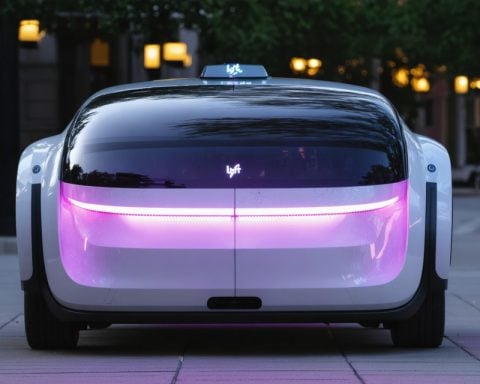- Nvidia’s GPUs are critical to AI development, helping it reach a market cap of $3.4 trillion.
- Amazon, under CEO Andy Jassy, is enhancing its AI capabilities to transform delivery and logistics with AI-powered robotics.
- Amazon Web Services (AWS) offers AI processors like Trainium and Inferentia to boost machine learning efficiency and cost-effectiveness.
- Amazon SageMaker empowers developers to create customized AI models, broadening AWS’s appeal.
- AI-driven targeted advertising is accelerating Amazon’s growth across its digital services.
- Nvidia faces challenges in AI chip market saturation, while Amazon could surpass Nvidia due to its strategic digital retail and AI advancements.
Over the past decade, the heartbeat of the tech world has synchronized with the rapid advancements in artificial intelligence, and no company embodies this pulse better than Nvidia. Known for its powerful GPUs, Nvidia has afforded technology giants the muscle required to push AI boundaries, reaching a towering market cap of $3.4 trillion.
Meanwhile, Amazon quietly sharpens its AI arsenal, and its ambitions are nothing short of astronomical. The e-commerce giant, nestled in a landscape dominated by digital retail and cloud computing, is readying itself for a future in which AI directs much of its strategic growth. Under the watchful eye of CEO Andy Jassy, Amazon is revolutionizing fulfillment with AI-powered robotics to slash delivery times and costs, factors crucial to its bottom line.
Across its formidable cloud platform, Amazon Web Services (AWS) has crafted AI-powered processors like Trainium and Inferentia. These cutting-edge chips promise efficiency and affordability for businesses eager to delve into machine learning. AWS’s toolbox doesn’t end there; it hands developers the keys to the AI kingdom with Amazon SageMaker, facilitating the creation of bespoke AI models.
Beyond logistics and cloud computing, AI steers Amazon’s advertising juggernaut. Targeted ads ingrained in its e-commerce, Prime Music, and streaming services are transforming this segment into Amazon’s fastest-growing venture.
While Nvidia must navigate potential pitfalls of AI chip saturation and evolving tech demands, Amazon stands at the cusp of outpacing Nvidia before the decade closes. With a firm grip on digital retail, cloud dominance, and unprecedented AI innovation, Amazon may very well leapfrog over Nvidia’s towering stature, reshaping the tech titans’ hierarchy.
Could Amazon Overtake Nvidia in the AI Race? Here’s What You Need to Know
How-To Steps & Life Hacks in the AI Industry
1. Choosing the Right GPU for AI Development:
– If you’re developing AI models, consider Nvidia’s GPUs. Their power and efficiency make them the go-to choice for AI, boasting superior support for frameworks like TensorFlow and PyTorch. Nvidia’s GeForce RTX 30 series and A100 are highly recommended.
2. Utilizing AWS for AI Projects:
– Leverage AWS’s AI services like Amazon SageMaker to create and deploy machine learning models. For scalable ML workloads, explore AWS’s Trainium and Inferentia chips, which optimize cost and performance.
3. Integrating AI into E-commerce:
– Use Amazon’s AI tools to enhance your e-commerce site with personalized recommendations and dynamic pricing strategies, improving user experience and sales conversion.
Real-World Use Cases
– Nvidia in Autonomous Vehicles:
Nvidia’s tech powers the automotive industry’s move toward self-driving cars. Its Drive platform is used for AI-based vehicle perception and safety measures.
– AWS in Healthcare:
AWS’s AI capabilities are transforming healthcare with applications like predictive diagnostics and personalized treatments, thanks to AI-enhanced data analysis.
Market Forecasts & Industry Trends
– AI Market Growth:
The AI market, anticipated to grow over $500 billion by 2024, sees Nvidia and Amazon as frontrunners due to their infrastructural capabilities and innovation (Source: IDC).
– AI in Cloud Computing:
Cloud-based AI is anticipated to dominate the market as businesses prioritize scalability and flexibility, with AWS leading the charge.
Reviews & Comparisons
– Nvidia vs. Amazon in AI:
While Nvidia excels in hardware (GPUs), Amazon thrives in software services and cloud infrastructure. Nvidia’s hardware remains unparalleled for high-performance tasks, but AWS’s extensive AI service portfolio is a major draw for businesses.
Controversies & Limitations
– AI Ethics and Bias:
As AI solutions proliferate, both Nvidia and Amazon face scrutiny regarding the ethical implications of AI technologies. Key concerns include bias in AI algorithms and privacy issues, demanding stringent oversight.
– Nvidia’s Market Challenges:
Nvidia must cope with potential market saturation and challenges from emerging AI chipmakers.
Features, Specs & Pricing
– Nvidia GPUs:
Known for their high processing power and efficiency, Nvidia’s GPUs like the RTX 3090 are priced for both consumer and enterprise needs, starting in the range of hundreds to thousands of dollars.
– AWS AI Services:
AWS offers a pay-as-you-go pricing model, scalable based on usage, making it cost-effective for businesses of all sizes.
Security & Sustainability
– Security Features:
Both Nvidia and AWS place a high premium on security with ongoing updates. AWS offers robust encryption and compliance services, while Nvidia focuses on secure boot processes in its chips.
– Sustainability Initiatives:
Nvidia has committed to reducing carbon emissions in production, while AWS has pledged carbon neutrality by 2040, leveraging renewable energy in their data centers.
Insights & Predictions
– AI’s Future Trajectory:
AI’s growth trajectory suggests increased competition and collaboration, with both Amazon and Nvidia poised to innovate and lead in AI efficiencies and applications.
Tutorials & Compatibility
– Compatibility Tips:
– Ensure your AI application’s compatibility with AWS cloud services through detailed tutorials available on AWS documentation.
– Nvidia provides software development kits (SDKs) to optimize AI applications for their GPUs.
Pros & Cons Overview
– Nvidia Pros:
– Industry-leading GPUs
– Strong presence in gaming and automotive AI
– Nvidia Cons:
– Hardware-focused, limited software portfolio
– Amazon Pros:
– Comprehensive AI cloud services
– Untapped e-commerce integration potential
– Amazon Cons:
– Relies on third-party hardware for non-cloud applications
Actionable Recommendations
– For businesses: Invest in training for cloud-based AI services like AWS to maximize efficiency.
– For developers: Experiment with Nvidia’s hardware to optimize performance for AI models.
– Monitor emerging trends and prepare adaptable strategies to maintain competitiveness in this rapidly evolving sector.
For more insights, explore official pages for more details:
– link to Nvidia
– link to AWS
















